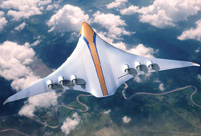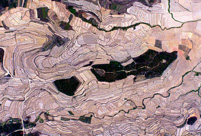

A new kind of galactic beast has been spotted in space.
Dubbed 'super spirals,' these galaxies dwarf our own and compete in size and brightness with the largest galaxies in the universe.
Super spirals have long hidden in plain sight by mimicking the appearance of typical spiral galaxies.
Now a new study using archived Nasa data reveals these seemingly nearby objects are in fact distant, behemoth versions of everyday spirals.
Pictured is a huge galaxy with the moniker SDSS J094700.08+254045.7. The galaxy stands as one of the biggest and brightest super spirals. The mega-galaxy's starry disk and spiral arms stretch about 320,000 light-years across, or more than three times the breadth of the Milky Way
Understanding more about these super spirals could shed light on how some of the biggest galaxies emerge.
Rare, super spiral galaxies present researchers with the major mystery of how such giants could have arisen.
'We have found a previously unrecognized class of spiral galaxies that are as luminous and massive as the biggest, brightest galaxies we know of,' said Patrick Ogle, an astrophysicist at Nasa.
'It's as if we have just discovered a new land animal stomping around that is the size of an elephant but had shockingly gone unnoticed by zoologists.'
Ogle and colleagues chanced upon super spirals as they searched for extremely luminous, massive galaxies in the Nasa/IPAC Extragalactic Database.
Known as Ned , this is an online repository containing information on over 100 million galaxies.
Ned brings together a wealth of data from many different projects, including ultraviolet light observations from the Galaxy Evolution Explorer and visible light from Sloan Digital Sky Survey.
In a sample of approximately 800,000 galaxies no more than 3.5 billion light-years from Earth, 53 of the brightest galaxies intriguingly had a spiral, rather than elliptical, shape.
 |
 Thai most beautiful transgender Nong Poy release new photos
Thai most beautiful transgender Nong Poy release new photos Now and then photos of Shanghai Jiaotong University
Now and then photos of Shanghai Jiaotong University Is this what air travel will look like in 2050?
Is this what air travel will look like in 2050? Aerial view of watermelon terraces in S China's Baise
Aerial view of watermelon terraces in S China's Baise Traditional wedding of a post-80s Tibetan couple
Traditional wedding of a post-80s Tibetan couple Models in cheongsams present classical oriental beauty
Models in cheongsams present classical oriental beauty Second commissioned C28A corvette made by China enters Algerian Navy
Second commissioned C28A corvette made by China enters Algerian Navy Intoxicating Wuyuan in spring
Intoxicating Wuyuan in spring Gold and silver wares of Qing Dynasty exhibited in Shenyang Imperial Palace
Gold and silver wares of Qing Dynasty exhibited in Shenyang Imperial Palace Top 20 hottest women in the world in 2014
Top 20 hottest women in the world in 2014 Top 10 hardest languages to learn
Top 10 hardest languages to learn 10 Chinese female stars with most beautiful faces
10 Chinese female stars with most beautiful faces China’s Top 10 Unique Bridges, Highways and Roads
China’s Top 10 Unique Bridges, Highways and Roads Challenges seen in attracting foreign capital
Challenges seen in attracting foreign capital  Suspected matricide case highlights mental health problems in China’s elite colleges
Suspected matricide case highlights mental health problems in China’s elite colleges  Peering into North Korea from China’s border
Peering into North Korea from China’s border  Cross-Straits ‘diplomatic truce’ still holds
Cross-Straits ‘diplomatic truce’ still holds Day|Week